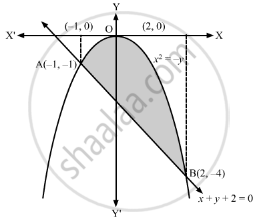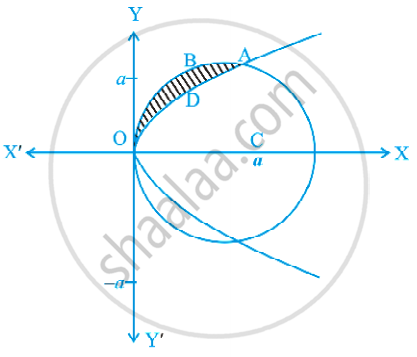Advertisements
Advertisements
Question
Find the area enclosed by the curve \[y = - x^2\] and the straight line x + y + 2 = 0.
Solution
The curve \[y = - x^2\] represents a parabola opening towards the negative y-axis.
The straight line x + y + 2 = 0 passes through (−2, 0) and (0, −2).
Solving
\[y = - x^2\] and x + y + 2 = 0, we get
\[x - x^2 + 2 = 0\]
\[ \Rightarrow x^2 - x - 2 = 0\]
\[ \Rightarrow \left( x - 2 \right)\left( x + 1 \right) = 0\]
\[ \Rightarrow x = 2\text{ or }x = - 1\]
Thus, the parabola \[y = - x^2\] and the straight line x + y + 2 = 0 intersect at A(−1, −1) and B(2, −4).
∴ Required area = Area of the shaded region OABO
\[= \left| \int_{- 1}^2 y_{\text{ line }} dx - \int_{- 1}^2 y_{\text{ parabola }} dx \right|\]
\[ = \left| \int_{- 1}^2 - \left( x + 2 \right)dx - \int_{- 1}^2 - x^2 dx \right|\]
\[ = \left.\left| {- \frac{\left( x + 2 \right)^2}{2}}\right|_{- 1}^2 +\left. \frac{x^3}{3}\right|_{- 1}^2 \right|\]
\[ = \left| - \frac{1}{2}\left( 16 - 1 \right) + \frac{1}{3}\left[ 8 - \left( - 1 \right) \right] \right|\]
\[ = \left| - \frac{15}{2} + 3 \right|\]
\[ = \left| - \frac{9}{2} \right|\]
\[ = \frac{9}{2}\text{ square units }\]
APPEARS IN
RELATED QUESTIONS
Find the area of the region bounded by the parabola y2 = 4ax and its latus rectum.
Prove that the curves y2 = 4x and x2 = 4y divide the area of square bounded by x = 0, x = 4, y = 4 and y = 0 into three equal parts.
Find the area of the region bounded by the curve x2 = 16y, lines y = 2, y = 6 and Y-axis lying in the first quadrant.
Area bounded by the curve y = x3, the x-axis and the ordinates x = –2 and x = 1 is ______.
The area bounded by the curve y = x | x|, x-axis and the ordinates x = –1 and x = 1 is given by ______.
[Hint: y = x2 if x > 0 and y = –x2 if x < 0]
Sketch the graph y = | x − 5 |. Evaluate \[\int\limits_0^1 \left| x - 5 \right| dx\]. What does this value of the integral represent on the graph.
Find the area of the region bounded by x2 = 16y, y = 1, y = 4 and the y-axis in the first quadrant.
Find the area of the region \[\left\{ \left( x, y \right): \frac{x^2}{a^2} + \frac{y^2}{b^2} \leq 1 \leq \frac{x}{a} + \frac{y}{b} \right\}\]
Using integration, find the area of the region bounded by the triangle whose vertices are (2, 1), (3, 4) and (5, 2).
Draw a rough sketch of the region {(x, y) : y2 ≤ 5x, 5x2 + 5y2 ≤ 36} and find the area enclosed by the region using method of integration.
Find the area common to the circle x2 + y2 = 16 a2 and the parabola y2 = 6 ax.
OR
Find the area of the region {(x, y) : y2 ≤ 6ax} and {(x, y) : x2 + y2 ≤ 16a2}.
Find the area of the region enclosed between the two curves x2 + y2 = 9 and (x − 3)2 + y2 = 9.
In what ratio does the x-axis divide the area of the region bounded by the parabolas y = 4x − x2 and y = x2− x?
Find the area bounded by the parabola x = 8 + 2y − y2; the y-axis and the lines y = −1 and y = 3.
Find the area bounded by the parabola y2 = 4x and the line y = 2x − 4 By using horizontal strips.
If the area above the x-axis, bounded by the curves y = 2kx and x = 0, and x = 2 is \[\frac{3}{\log_e 2}\], then the value of k is __________ .
The area included between the parabolas y2 = 4x and x2 = 4y is (in square units)
The area bounded by y = 2 − x2 and x + y = 0 is _________ .
The area bounded by the curve y = 4x − x2 and the x-axis is __________ .
The area bounded by the curve y = f (x), x-axis, and the ordinates x = 1 and x = b is (b −1) sin (3b + 4). Then, f (x) is __________ .
Find the equation of the standard ellipse, taking its axes as the coordinate axes, whose minor axis is equal to the distance between the foci and whose length of the latus rectum is 10. Also, find its eccentricity.
Using the method of integration, find the area of the region bounded by the lines 3x − 2y + 1 = 0, 2x + 3y − 21 = 0 and x − 5y + 9 = 0
Find the area of the curve y = sin x between 0 and π.
Find the area of the region bounded by the parabola y2 = 2x and the straight line x – y = 4.
Find the area of the region above the x-axis, included between the parabola y2 = ax and the circle x2 + y2 = 2ax.
Find the area bounded by the curve y = sinx between x = 0 and x = 2π.
The area of the region bounded by the y-axis, y = cosx and y = sinx, 0 ≤ x ≤ `pi/2` is ______.
Area of the region in the first quadrant enclosed by the x-axis, the line y = x and the circle x2 + y2 = 32 is ______.
Area of the region bounded by the curve y = cosx between x = 0 and x = π is ______.
The area of the region bounded by the curve y = x + 1 and the lines x = 2 and x = 3 is ______.
Using integration, find the area of the region in the first quadrant enclosed by the line x + y = 2, the parabola y2 = x and the x-axis.
The region bounded by the curves `x = 1/2, x = 2, y = log x` and `y = 2^x`, then the area of this region, is
Area of the region bounded by the curve `y^2 = 4x`, `y`-axis and the line `y` = 3 is:
The area (in sq.units) of the region A = {(x, y) ∈ R × R/0 ≤ x ≤ 3, 0 ≤ y ≤ 4, y ≤x2 + 3x} is ______.
Let f : [–2, 3] `rightarrow` [0, ∞) be a continuous function such that f(1 – x) = f(x) for all x ∈ [–2, 3]. If R1 is the numerical value of the area of the region bounded by y = f(x), x = –2, x = 3 and the axis of x and R2 = `int_-2^3 xf(x)dx`, then ______.
Find the area of the following region using integration ((x, y) : y2 ≤ 2x and y ≥ x – 4).
Find the area of the minor segment of the circle x2 + y2 = 4 cut off by the line x = 1, using integration.
